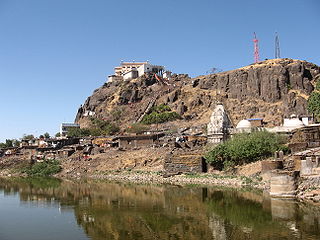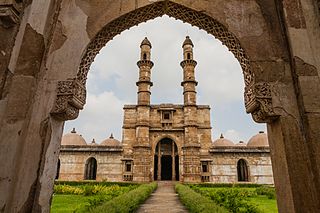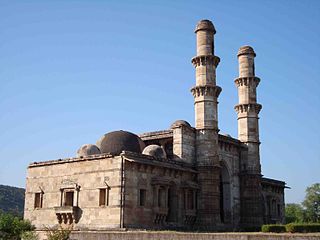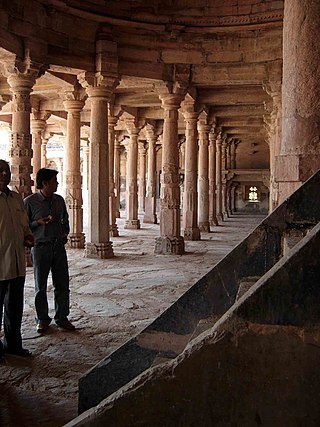Mahmud Begada or Mahmud Shah I was the most prominent Sultan of the Gujarat Sultanate. Raised to the throne at young age, he successfully captured Pavagadh and Junagadh forts in battles which gave him his name Begada. He established Champaner as the capital.
Champaner is a historical town in the state of Gujarat, in western India. It is located in Panchmahal district, 47 kilometres from the city of Vadodara. The city was briefly the capital of the Sultanate of Gujarat.At an early period Chámpáner was the seat of a Bhil dynasty. Champaner was founded by King Champa Bhil.

Indo-Islamic architecture is the architecture of the Indian subcontinent produced by and for Islamic patrons and purposes. Despite an initial Arab presence in Sindh, the development of Indo-Islamic architecture began in earnest with the establishment of Delhi as the capital of the Ghurid dynasty in 1193. Succeeding the Ghurids was the Delhi Sultanate, a series of Central Asian dynasties that consolidated much of North, East, and Central India, and later by the Mughal Empire during the early 16th century. Both of these dynasties introduced Islamic architecture and art styles from West Asia into the Indian subcontinent.

Champaner-Pavagadh Archaeological Park, a UNESCO World Heritage Site, is located in Panchmahal district in Gujarat, India. It is located around the historical city of Champaner, a city which was founded by Vanraj Chavda, the most prominent king of the Chavda Dynasty, in the eighth century. He named it after the name of his friend and general Champa, also known later as Champaraj. The heritage site is studded with forts with bastions starting from the hills of Pavagadh, and extending into the city of Champaner. The park's landscape includes archaeological, historic and living cultural heritage monuments such as chalcolithic sites, a hill fortress of an early Hindu capital, and remains of the 16th-century capital of the state of Gujarat. There are palaces, entrance gates and arches, mosques, tombs and temples, residential complexes, agricultural structures and water installations such as stepwells and tanks, dating from the eighth to the 14th centuries. The Kalika Mata Temple, located on top of the 800 metres (2,600 ft) high Pavagadh Hill, is an important Hindu shrine in the region, attracting large numbers of pilgrims throughout the year.

Pavagadh is a municipal operated region in Panchmahal district about 46 kilometres (29 mi) away from Vadodara in Gujarat state in western India. It is known for a famous Mahakali temple which is one of the 51 Shaktipeeths and draws thousands of pilgrims every day. However, as per records, this was originally a Jain temple belonging to the Svetambara Achalgaccha, whose Adhistayika Mahakali's idol was installed here in the 12th century. This locality Champaner-Pavagadh Archaeological Park was declared by UNESCO as a World Heritage Site in 2004.

The Gujarat Sultanate or Sultanate of Guzerat was a late medieval Islamic Indian kingdom in Western India, primarily in the present-day state of Gujarat. The kingdom was established in 1394 when Muzaffar Shah I, the Governor of Gujarat, declared independence from the Tughlaq dynasty of Delhi.

Jama Masjid, also known as Jumah Mosque or Jami' Masjid, is a mosque in Ahmedabad, Gujarat, India. It was built in 1424 during the reign of Ahmad Shah I. The inscription on the central mihrab commemorates the inauguration of the mosque on the 1st Safar A.H. 827 or January 4, 1424 A.D. by Sultan Ahmad Shah I. The mosque lies in the old walled city, and it is situated outside Bhadra Fort area. The old walled city is divided into separate quarters or pols, and the Jami' Masjid is found on the Gandhi Road. Along the south side of the road, the mosque is a short distance beyond the Teen Darwaza or Tripolia Gate.

Pavagadh Hill is situated within a plain in Panchmahal district, Gujarat, western India. A volcanic eruption occurred in the region approximately 500 million years ago and the etymology of Pavagadh is associated with this eruption: Pav-gadh means "one fourth hill" or "fire-hill". At its base is the historical city of Champaner, while the hill station of Pavagadh was built upon the volcanic cone itself. With Champaner, Pavagadh hill forms the Champaner-Pavagadh Archaeological Park, a UNESCO World Heritage Site which is spread over an area of more than 1,329 hectares. Known for its forts, there are also dozens of heritage structures on the hill. The site is 50 kilometres (31 mi) east of Vadodara and 68 kilometres (42 mi) south of Godhra.

Jami Masjid in Champaner, Gujarat state, western India, is part of the Champaner-Pavagadh Archaeological Park, a UNESCO World Heritage Site, and is among the 114 monuments there which are listed by the Baroda Heritage Trust. It is located about 150 feet (46 m) east of the city walls (Jahdnpandh), near the east gate.

Kevada Mosque is a mosque in Champaner, Gujarat state, western India. It is part of the Champaner-Pavagadh Archaeological Park, a UNESCO World Heritage Site. The mosque has minarets, globe-like domes, and narrow stairs. According to Ruggles (2008), nature was integrated into the Kevada mosque's architecture in a way that was unusual elsewhere in the Islamic world.

Bawaman Mosque is a mosque in Champaner, western India. It is situated on the western side of one of the ancient city's fort gates, within the Champaner-Pavagadh Archaeological Park of Gujarat.

There are eleven different types of buildings at the UNESCO-protected Champaner-Pavagadh Archaeological Park in Gujarat, India, including mosques, temples, granaries, tombs, wells, walls, and terraces. The monuments are situated at the foot of and around the Pavagadh Hill. The Baroda Heritage Trust lists 114 monuments in the area, of which only 39 are maintained by the Archaeological Survey of India, due to limited funding. The Forest Department owns 94% of the land here, while the temple trusts and other sectarian establishments provide facilities for boarding and lodging to pilgrims and tourists. On the southern side near the foot of the hill some dilapidated houses and the foundations of Jain temples can also be seen.

Lila Gumbaj Ki Mosque in Champaner, Gujarat state, western India is one of the 114 monuments listed by the Baroda Heritage Trust that are part of the Champaner-Pavagadh Archaeological Park, a UNESCO World Heritage Site. It is located near the east gate of the former city.

Achut Bibi's Mosque and Tomb, also known as Shahi Masjid locally, is a medieval mosque and tomb complex on the bank of Sabarmati river in Dudheshwar, Ahmedabad, India.

Baba Lului's Mosque, also known as Baba Lavlavie's Masjid, is a medieval mosque and tomb complex in Behrampura area of Ahmedabad, India.
Malik Isan's Mosque, also known as Isanpur Mosque or Gumle Masjid, is a medieval mosque in Isanpur area of Ahmedabad, India.

Lat Mosque is a mosque in Dhar in Madhya Pradesh, India. Named after the Iron pillar of Dhar, it is also known as Lat ki masjid, Ladh Masjid, or Lath Masjid.

Sakar Khan mausoleum located in Halol, Gujarat, is a dargah or mausoleum of Sakar Khan. It is the largest in the old part of Champaner. Dargah has a low plinth and a large dome, with windows in the frontage.
The Architecture of Gujarat consists of architecture in the Indian state of Gujarat.

Bibi Ki Masjid, also known as Bibi Saheba Masjid is a mosque in Burhanpur, in the Indian state of Madhya Pradesh. It is listed as a monument of national importance.


















